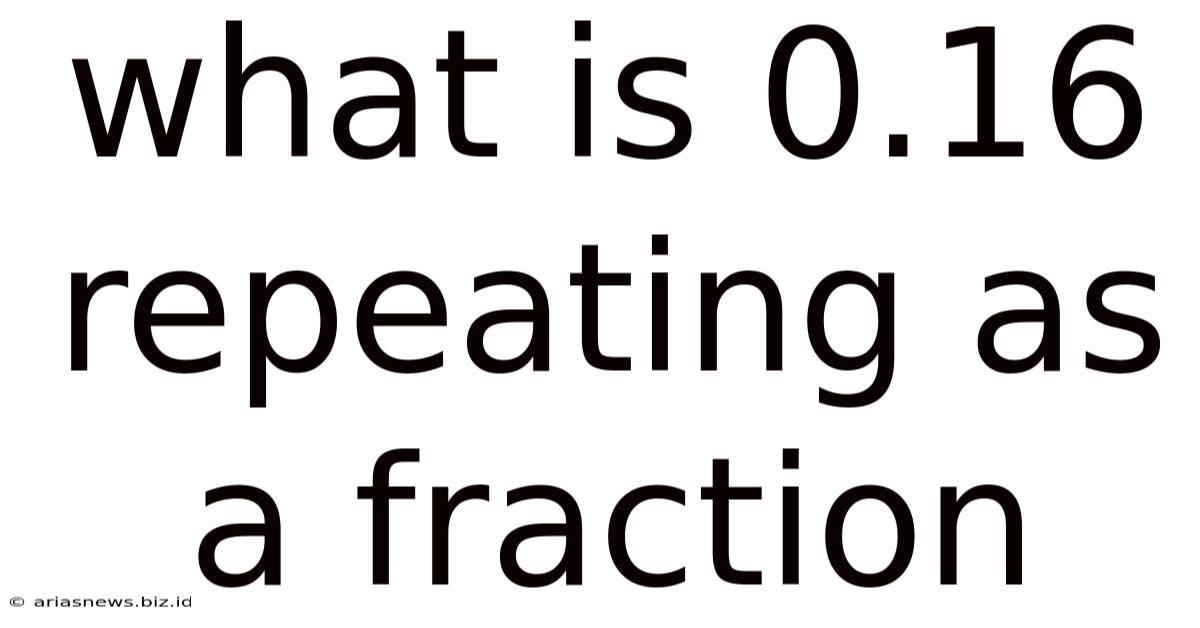What Is 0.16 Repeating As A Fraction
Arias News
May 11, 2025 · 4 min read

Table of Contents
What is 0.16 Repeating as a Fraction? A Comprehensive Guide
Understanding how to convert repeating decimals into fractions is a fundamental skill in mathematics. This comprehensive guide will delve into the process of converting the repeating decimal 0.161616... (or 0.16 with a bar over the 16 signifying repetition) into its fractional equivalent. We'll explore multiple methods, discuss the underlying mathematical principles, and provide practical examples to solidify your understanding.
Understanding Repeating Decimals
Before we jump into the conversion, let's clarify what a repeating decimal is. A repeating decimal, also known as a recurring decimal, is a decimal number that has a digit or a group of digits that repeat infinitely. The repeating part is indicated by placing a bar over the repeating digits. For instance:
- 0.333... is written as 0.<u>3</u>
- 0.121212... is written as 0.<u>12</u>
- 0.161616... is written as 0.<u>16</u>
These repeating decimals represent rational numbers – numbers that can be expressed as a fraction of two integers (a/b, where 'a' and 'b' are integers and b ≠ 0). Our focus will be on converting 0.<u>16</u> into its fractional form.
Method 1: Using Algebra to Solve for x
This is a classic and widely used method for converting repeating decimals to fractions. Let's break it down step-by-step:
-
Assign a variable: Let x = 0.<u>16</u>
-
Multiply to shift the decimal: Multiply both sides of the equation by 100 (since two digits are repeating): 100x = 16.<u>16</u>
-
Subtract the original equation: Subtract the original equation (x = 0.<u>16</u>) from the equation obtained in step 2:
100x – x = 16.<u>16</u> – 0.<u>16</u>
This simplifies to: 99x = 16
-
Solve for x: Divide both sides by 99:
x = 16/99
Therefore, 0.<u>16</u> is equal to 16/99.
Method 2: Using the Formula for Repeating Decimals
A more generalized formula can be derived for converting repeating decimals. This formula streamlines the process, particularly useful for longer repeating sequences.
The general formula is:
x = (Repeating digits) / (9 repeated nine times)
Let's apply this to our example:
x = 16/99
This formula directly gives us the fraction, simplifying the algebraic steps. The number of nines in the denominator corresponds to the number of repeating digits. For instance, if the repeating decimal was 0.<u>123</u>, the fraction would be 123/999.
Method 3: Understanding the Underlying Concept
The methods above work, but it's crucial to understand why they work. Repeating decimals represent an infinite geometric series. Let's look at 0.<u>16</u> as a series:
0.16 + 0.0016 + 0.000016 + ...
This is a geometric series with the first term (a) = 0.16 and the common ratio (r) = 0.01. The sum of an infinite geometric series is given by the formula:
Sum = a / (1 - r)
Substituting our values:
Sum = 0.16 / (1 - 0.01) = 0.16 / 0.99 = 16/99
This reinforces the result obtained through the algebraic and formulaic methods.
Verification and Simplification
It's always a good practice to verify the fraction. You can use a calculator to divide 16 by 99. The result will be 0.161616..., confirming our conversion.
The fraction 16/99 is already in its simplest form. There are no common factors between 16 and 99 other than 1.
Practical Applications and Extensions
The ability to convert repeating decimals to fractions is not just a theoretical exercise; it has practical applications in various fields:
- Engineering and Physics: Accurate calculations often require fractional representations, especially when dealing with ratios and proportions.
- Computer Science: Representing numbers in binary and other bases requires understanding decimal representations.
- Finance and Accounting: Working with precise monetary values often needs converting repeating decimals for accuracy.
Dealing with More Complex Repeating Decimals
The methods described above can be extended to handle more complex repeating decimals. For example, consider the number 0.12<u>34</u>, where only 34 repeats:
- Let x = 0.12<u>34</u>
- Multiply by 100 to shift the repeating part to the left of the decimal: 100x = 12.<u>34</u>
- Multiply by 10000 to isolate the repeating part: 10000x = 1234.<u>34</u>
- Subtract the equation in step 2 from the equation in step 3: 9900x = 1222
- Solve for x: x = 1222/9900
This fraction can then be simplified by finding the greatest common divisor of the numerator and denominator.
Conclusion: Mastering the Conversion
Converting repeating decimals to fractions is a crucial mathematical skill. By understanding the algebraic approach, utilizing the formula for repeating decimals, and grasping the underlying concept of geometric series, you'll be equipped to tackle a wide range of repeating decimal conversions with confidence. Remember to always verify your results and simplify the fraction to its simplest form. Mastering this skill provides a solid foundation for tackling more advanced mathematical concepts and real-world problem-solving. Practice regularly with different repeating decimals to strengthen your understanding and improve your speed and accuracy.
Latest Posts
Latest Posts
-
1 Cent Equal To How Many Meters
May 11, 2025
-
How Many Slices Of Bacon Is 6 Oz
May 11, 2025
-
What Is The Gcf Of 15 And 21
May 11, 2025
-
How Much Vinyl Siding In A Square
May 11, 2025
-
What Happens When Cupid Shoots An Arrow Answer Key
May 11, 2025
Related Post
Thank you for visiting our website which covers about What Is 0.16 Repeating As A Fraction . We hope the information provided has been useful to you. Feel free to contact us if you have any questions or need further assistance. See you next time and don't miss to bookmark.